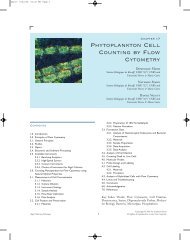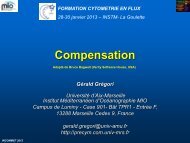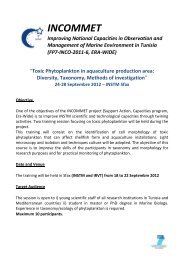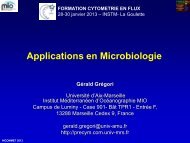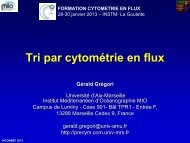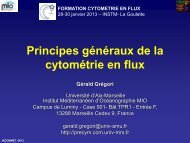Eukaryotic Picoplankton in Surface Oceans - incommet
Eukaryotic Picoplankton in Surface Oceans - incommet
Eukaryotic Picoplankton in Surface Oceans - incommet
Create successful ePaper yourself
Turn your PDF publications into a flip-book with our unique Google optimized e-Paper software.
Annu. Rev. Microbiol. 2011.65:91-110. Downloaded from www.annualreviews.org<br />
by CSIC - Consejo Superior de Investigaciones Cientificas on 09/27/11. For personal use only.<br />
contributes to the OTU number <strong>in</strong> proportion<br />
to its relative clonal abundance (Figure 4d). In<br />
addition, the group novelty can be reported by<br />
compar<strong>in</strong>g the closest environmental and cultured<br />
BLAST matches of its sequences (19).<br />
This po<strong>in</strong>ts to groups requir<strong>in</strong>g more cultur<strong>in</strong>g<br />
and/or sequenc<strong>in</strong>g effort. F<strong>in</strong>ally, sequences<br />
that do not belong to any taxonomic group<br />
could represent novel evolutionary l<strong>in</strong>eages and<br />
thus deserve more attention.<br />
Translat<strong>in</strong>g OTUs <strong>in</strong>to<br />
a Taxonomic Rank<br />
It is desirable to determ<strong>in</strong>e the taxonomic rank<br />
of def<strong>in</strong>ed OTUs and <strong>in</strong> particular the cluster<strong>in</strong>g<br />
level that corresponds to species, the basic<br />
unit of diversity. Def<strong>in</strong><strong>in</strong>g species is often a controversial<br />
issue, and it is even more problematic<br />
among microbe-sized organisms (73). The biological<br />
species concept, group<strong>in</strong>g organisms by<br />
sexual <strong>in</strong>terbreed<strong>in</strong>g, applies to some diatoms<br />
or d<strong>in</strong>oflagellates and reveals that stra<strong>in</strong>s need<br />
100% rDNA identity to be sexually compatible<br />
(4). This refers to the dom<strong>in</strong>ant rDNA sequence<br />
with<strong>in</strong> a stra<strong>in</strong>. Although <strong>in</strong>tragenomic<br />
rDNA copies are not always identical, they are<br />
homogenized by concerted evolution, so the<br />
few variants are usually >99.5% similar to the<br />
dom<strong>in</strong>ant sequence (3). Little is known about<br />
sex <strong>in</strong> picoeukaryotes, but some h<strong>in</strong>ts suggest<br />
it may exist. On the one hand, picoeukaryote<br />
genomes reveal the complete suite of meiosis<br />
genes (41, 86), and recomb<strong>in</strong>ation between Ostreococcus<br />
stra<strong>in</strong>s has been detected, although the<br />
estimated frequency of sexual divisions was low<br />
(30). On the other hand, if picoeukaryotes were<br />
fully asexual, they could speciate as prokaryotes.<br />
Under the ecological species concept, organisms<br />
from the same species occupy<strong>in</strong>g the<br />
same niche accumulate neutral mutations until<br />
one genotype outcompetes the rest due to<br />
an adaptive mutation (15). Neutral mutations<br />
with periodic purg<strong>in</strong>g events could expla<strong>in</strong> the<br />
microdiversity found <strong>in</strong> prokaryotic surveys (1).<br />
In fact, such microdiverse clusters are also detected<br />
<strong>in</strong> picoeukaryote surveys, with ∼50% of<br />
rDNA sequences closely related (>99% similarity)<br />
but not identical.<br />
What cluster<strong>in</strong>g level should be used to<br />
group sequences from the same species? If picoeukaryotes<br />
had sex and consider<strong>in</strong>g the diatom<br />
<strong>in</strong>terbreed<strong>in</strong>g experiments (4), the advisable<br />
level would be 100%. So, they could<br />
engage <strong>in</strong> a sexual event periodically, perhaps<br />
triggered by environmental cues. If they were<br />
asexual, microdiverse clusters of highly related<br />
sequences could appear, and each <strong>in</strong>dividual<br />
variant would not correspond to a<br />
different species. However, the microdiversity<br />
detected can also be caused by other biological<br />
or methodological factors. So, cluster<strong>in</strong>g<br />
at 99% similarity seems to be a good compromise.<br />
This gives a conservative species number<br />
(some species will be lumped together) and<br />
avoids consider<strong>in</strong>g microdiversity, rDNA <strong>in</strong>tragenomic<br />
variability, and PCR or sequenc<strong>in</strong>g<br />
errors.<br />
Population Ecology and Biogeography<br />
The species distributional range of microbes is a<br />
controversial topic. In one view, the small body<br />
size of microbial taxa implies huge population<br />
sizes and ubiquitous dispersal, lead<strong>in</strong>g to cosmopolitan<br />
distributions and a low number of<br />
species globally (25). The opposite view accepts<br />
cosmopolitan species but claims the existence of<br />
endemic ones, lead<strong>in</strong>g to a much higher microbial<br />
diversity (26). Molecular surveys provide<br />
an objective way to assess microbial biogeography<br />
and offer good arguments for global distribution<br />
of mar<strong>in</strong>e microbes, as exemplified by<br />
MAST-4 cells (Figure 5). This picoeukaryote<br />
appears <strong>in</strong> all samples and accounts for ∼100<br />
cells ml −1 and ∼13% of heterotrophic flagellates<br />
globally (Figure 5a). MAST-4 sequences<br />
form five clades that exhibit a high <strong>in</strong>ternal similarity<br />
(Figure 5b) and a pan-oceanic distribution<br />
(Figure 5c). Thus, at the 18S rDNA level,<br />
there do not seem to be geographical barriers<br />
to the distribution of mar<strong>in</strong>e picoeukaryotes.<br />
More variable markers <strong>in</strong>deed highlight locally<br />
restricted populations with<strong>in</strong> a cosmopolitan<br />
rDNA type (70). Another relevant f<strong>in</strong>d<strong>in</strong>g of<br />
Microbial<br />
biogeography: study<br />
of the distribution of<br />
microbial species with<br />
a special focus on the<br />
existence of<br />
geographic barriers<br />
and endemic species<br />
www.annualreviews.org • Mar<strong>in</strong>e Picoeukaryotes 103



